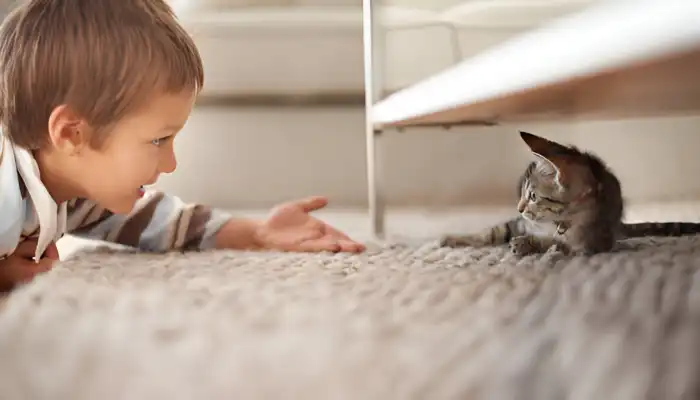How do I say “hello” in cat translator? If you have ever struggled to connect with your cat, you are far from having such experiences all by yourself. Cats do not say hello the way we do, but rather have several unique ways of greeting.
Cats meow and show different body movements and facial gestures. Each of these expresses something different. In this post, we will look into how cats say “hi” and show you how to use such greetings for a stronger association with your pet.

Understanding Cat Behavior
To get to the main point of how do I say “hello” in cat translator?, it is important first to discuss how cats interact and communicate with us through cat translator. They do not talk like we do. Rather, through their actions, sounds, and body movements, they have their way of saying “hi” to one another—and us too!
Primary Methods of Communication Used by Cats
Cats exhibit communication through:
- Vocalization (Meowing, Purring, Growling, Hissing)
- Body Language (Tail Flicks, Ear Positions, Posture)
- Facial Expressions (Eye Dunks and Blinking)
Why Cats Meow
While it could be debated that cats meow simply out of hunger or when they are irritated, some of them do so to greet someone. Although it is not the same way human beings greet each other. Cats will often say “hi” to their owners by using a soft and friendly meow or even a purr, which signals comfort and affection.
Did you know: Generally, cats do not start conversations with other cats using meows, but around humans, cats use it liberally. This means your cat is saying hi when he is meowing!
Common Ways Cats Say “Hello”
Having learned a bit more about how cats communicate, let’s focus on how they and we greet each other. Now, let’s explore the most common cat greetings and answer the question, “How do I say “hello” in cat translator? when your cat says ‘hello’ to us.
1. The Soft Meow
- When your cat softly meows, that’s their version of saying hello!
- Cats also purr and meow to alert people that they want attention or for whenever they want to communicate that they are there.
- Note: If your cat’s meow is high pitched and drawn out into sharp squeaks, then they are more than likely needing something, possibly food.
2. The Slow Blink
- Cats exhibit slow blinking as a sign of trust and affection.
- A slow blink from your cat is a sign that they’re saying, ”I am at ease when I am with you, and I trust you.”.
- To strengthen the bond, you can reciprocate this gesture by blinking slowly at your cat.
3. The Flick or Wagging of the Tail
- This is not a formal meowing cat greeting, but a cat flicking their tail is often a sign that they are thrilled to see you.
- In other situations, tail flicks can mean anger, so notice the other signs as well.
4. The Head Butts (Bunting)
- Cats also tend to rub their faces with one another when they meet, which is referred to as ‘bunting’.
- It is a form of appraisal that encourages marking and territoriality as well as bonding in cats.
- When your cat rubs its head against you, it is saying, “Hello.”.
Understanding your cats’ soft meows, tail flicks, slow blinks, and tail flicks will help you relate with them better on a deeper level and strengthen your relationship.
How People Can Copy a Cat’s Greeting
Now that you know how cats address each other, how do I say “hello” in cat translator? You must admit that it is quite difficult. However, you can mimic some of their natural mannerisms to greet them in a way they understand.
Top Techniques To Greet A Cat Like A Pro
- Slow Blink At Your Cat
- This gesture will stop your cat from mischief. You can derive some encouraging ideas from a cat that isn’t taming easily.
- How to do it: Just every day wink slowly and wait for your kitty to do the same. It’s your personal “hello.”
- Meow Back Softly
- When your feline companion lets out meows at you, reply with a gentle meow. Why not? Let’s keep talking!
- Pro Tip: The highest response from cats comes from soft and quick meows. Never shout or try talking loudly.
- Hand For Nose Touch
- To make your cat feel comfortable, place your palm in their direction the same way they head butting do.
- Give Them Some Room
- Like people, sometimes absence can make the heart fonder for cats too. If a cat does not want to be near the owner, the best approach is to leave the cat alone.
- Do not chase after the cat. Give them space and let them choose when and if they want to interact.
These behaviors or actions show how cats transmit their messages and emotions to their owners.
Now that you know how to greet your cat like a pro, try incorporating these simple gestures into your interactions. Whether it’s a slow blink, a gentle meow, or a nose touch, these behaviors will help deepen the connection you share with your feline friend.
Can Cat Translators Help?
You must have come across cat translators who claim to interpret your cat’s meows for a certain fee. The real question is, do cat translators help in any way?
How Do Cat Translator Devices Work?
Certain devices marketed as cat translators claim to record a pet’s sounds to “speak” to its owner. These machines and devices try to use the pitch and frequency of different cats’ yowls to decide what the cat is trying to say.
Here’s a quick summary of the information provided:
| Device | Claim | Accuracy |
|---|---|---|
| Cat Translator App | Translates cat sounds into the English vocabulary. | Can read a cat’s emotions and needs. |
| MeowTalk Translator | Can read a cat’s emotion and needs. | Monitors activity and health as well as translates meows. |
| PetPace Collar | Monitors activity and health, as well as translates meows. | Not a perfect translator but more of a health monitor. |
Are These Translators Reliable?
These types of devices are entertaining to try out and use, but they are not guaranteed to provide an accurate answer. These devices will provide a general idea of what your cat’s meowing means specifically, but not provide an actual translation word for word.
These tools add great amusement to the owner-pet relationship, but understanding your feline’s behavior with the techniques above will allow for a better bond to be created.
Conclusion
How do I say “hello” in cat translator? There might not be a universal solution, but knowing how to make sense of your cat’s communication is as important as anything else. Cats greet their fellow felines and humans with soft meows, slow blinks, and flicks of their tails.
Mimicking these behaviors helps strengthen your bond. While cat translators can be fun, they aren’t entirely reliable. The best way to say “hello” to your cat is through patience, observation, and reciprocating their unique greetings. Connecting with your cat through their natural communication will always be more meaningful than any translator.
